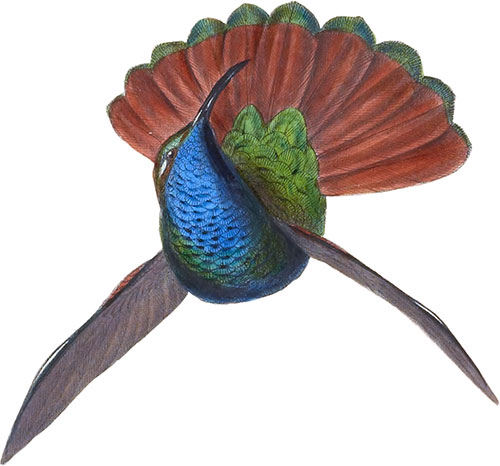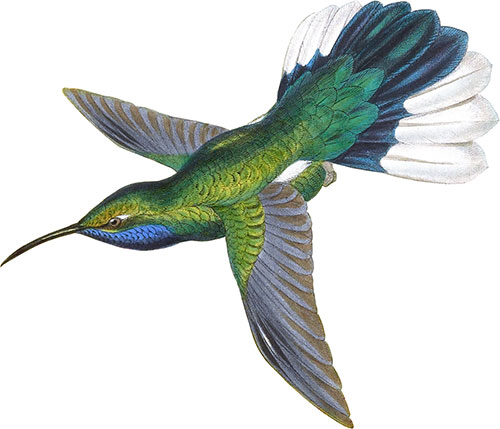Broad-shafted Sabre-wing
Cayenne and British Guiana
The Campylopterus latipennis is one of the very earliest-known species of Humming-Bird; a glance at the long list of names by which it has been described in the works of Linnæus, Boddaert, Gmelin, Latham, Buffon, &c., will at once induce the reader to come to such a conclusion.
Long known, however, as the species has been, no reliable information has been transmitted to us as to its habits and economy, or the specific purpose for which the broad shafts of the wings have been designed. They doubtless aid the bird in cleaving the air with great rapidity, but they perhaps have some other especial use, though what that may be cannot be easily imagined, since they do not occur in the females, and are only to be found in the very old males. If we wish to see this bird in a state of nature, a journey to Cayenne and French Guiana will enable us to attain the object of our desire, as it is in those countries, particularly Cayenne, that the specimens sent to Europe are collected. Of these the greater part are of course sent to Paris, whence they find their way to this country.
I believe I have still another species of this form from Ecuador, intermediate between C. latipennis and C. obscurus; but of this more at some other time, when additional specimens have arrived; at present I have only seen the one which graces my collection. This bird is certainly not the female of either of the abovementioned species; it has longer wings than either of them, and, moreover, differs in the extent of the white tipping of the outer tail-feathers.
Of the three or four known species of grey-breasted Campylopteri, the present has by far the greatest amount of white at the tips of the lateral tail-feathers.
I believe that no difference exists in the colouring of the sexes of the Campylopterus latipennis, and that the dilated shafts of the outer wing-feathers is the only tangible character by which the sexes can be distinguished.
Modern research has discovered that the earliest specific appellation assigned to this bird is that of largipennis, given to it by Boddaert; by that name, however, it is known to but few, while that of latipennis is just as familiar. I have therefore in this instance deviated from the law of priority, and adopted the term which is most generally applied to it.
Head, all the upper surface, wing- and tail-coverts, sides of the neck, and flanks deep oil-green; wings dark purplish brown; two centre tail-feathers dark green; the next on each side black, washed with green at the base, and slightly tipped with whitish; the remainder black, largely tipped with white; all the under surface dark grey; bill black.
The figures are of the natural size. The plant is the Odontoglossum hastilabium, var. fuscatum.
 Campyloterus lazulus
Lazuline Sabre-wing
Campyloterus lazulus
Lazuline Sabre-wing
 Campylopterus Delattrei
De Lattre’s Sabre-wing
Campylopterus Delattrei
De Lattre’s Sabre-wing
 Campylopterus ensipennis
Blue-throated Sabre-wing
Campylopterus ensipennis
Blue-throated Sabre-wing
 Campylopterus splendens
Villavicencio’s Sabre-wing
Campylopterus splendens
Villavicencio’s Sabre-wing
 Campylopterus Villavicencio
Villavicencio’s Sabre-wing
Campylopterus Villavicencio
Villavicencio’s Sabre-wing
 Campylopterus obscurus
Sombre Sabre-wing
Campylopterus obscurus
Sombre Sabre-wing
 Campylopterus rufus
Fawn-breasted Sabre-wing
Campylopterus rufus
Fawn-breasted Sabre-wing
 Campylopterus hyperythrus
Rufous-breasted Sabre-wing
Campylopterus hyperythrus
Rufous-breasted Sabre-wing
 Campylopterus phainopeplus
Simons’s Sabre-wing
Campylopterus phainopeplus
Simons’s Sabre-wing
Featuring all 422 illustrated species from John Gould’s A Monograph of the Trochilidæ, or Family of Humming-Birds arranged by color.